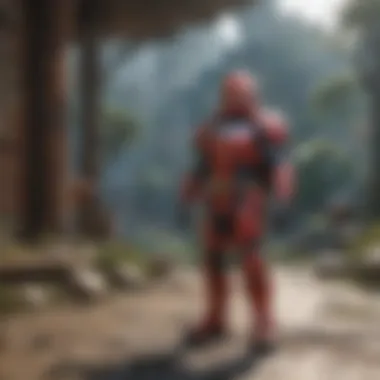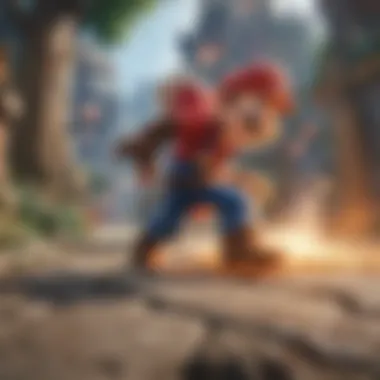Decoding the Intricacies of Smash Bros Ultimate Tier Lists: A Detailed Analysis


Overview of the Game
Super Smash Bros Ultimate is a popular and critically acclaimed fighting game released on December 7, 2018. Developed by Nintendo for their Switch console, this game falls under the genre of fighting games with a unique twist that sets it apart from traditional fighters.
Tier List Analysis
Tier lists in Super Smash Bros Ultimate serve as a hierarchical ranking system for characters based on their competitive viability. These lists are compiled by experts in the community who assess each fighter's strengths, weaknesses, and overall performance in various matchups. Understanding tier list placement is crucial for players looking to excel in competitive play.
Compilation Methodologies
Tier lists are often created by aggregating opinions from top players, tournament results, matchup spreads, and character specific attributes. The methodology behind compiling these lists involves meticulous analysis and comparison of each character's tools, combo potential, recovery options, movement capabilities, and overall viability in the current meta.
Top-Tier Picks
In the upper echelons of Smash Bros Ultimate tier lists, characters like Pikachu, Peach, Pichu, and Joker shine brightly. These top-tier contenders boast high combo potential, strong matchups against a wide range of characters, and exceptional tools that give them an edge in competitive settings. Experienced players often gravitate towards these characters to maximize their chances of success.
Relevance to Players
Understanding tier lists provides players with strategic insights into character selection, matchup knowledge, and tournament performance expectations. By keeping track of tier list updates and meta shifts, gamers can adapt their playstyles, refine their skills, and make informed decisions when choosing their main characters.
Introduction
In the vast and intricate realm of competitive gaming, understanding the nuances of tier lists in Smash Bros Ultimate holds paramount importance. This article embarks on a journey to dissect and demystify these tier lists, shedding light on the very essence of character rankings and the underlying factors that influence their placements. Delving deep into the methodologies, top-tier contenders, and the significance these lists hold within both casual play and competitive scenes, this comprehensive analysis aims to offer valuable insights to enthusiasts of the game.
Understanding Tier Lists in Smash Bros Ultimate
Definition and Purpose of Tier Lists
Tier lists serve as a cornerstone in the competitive landscape of Smash Bros Ultimate, offering a structured ranking system that categorizes characters based on their perceived strength and effectiveness in play. The essence of tier lists lies in providing players with valuable insights into the relative power levels of different characters, thereby aiding in strategic decision-making and gameplay optimizations. While these tier lists are a prevalent fixture in the gaming community, they also provoke debates and discussions on character balance and viability. Understanding the definition and purpose of tier lists is crucial as it forms the foundation on which players base their character selections and gameplay strategies.
Evolution of Tier List Culture in the Smash Community
The evolution of tier list culture within the Smash community can be traced back to the inception of the series, with a gradual refinement of methodologies and criteria used for character evaluations. As the game evolved and new iterations were released, the community's approach to tier lists also evolved, incorporating player insights, tournament results, and gameplay trends into the ranking process. This evolution mirrors the ever-changing dynamics of competitive gaming, illustrating how perceptions of character strength can shift over time. Recognizing this evolution is essential for players seeking to grasp the intricacies of tier lists and how they impact the competitive framework.
Significance of Tier Lists in Competitive Play
Impact on Player Strategies
Tier lists play a pivotal role in shaping player strategies by providing a structured hierarchy of character strength. Players often turn to tier lists to identify top-performing characters, optimal matchups, and effective playstyles. The impact of tier lists on player strategies is profound, influencing not only character selection but also tactical approaches and decision-making during gameplay. By understanding how tier lists influence player strategies, competitors can adapt and evolve their gameplay to align with the perceived strengths and weaknesses of different characters.
Influence on Tournament Results


The influence of tier lists on tournament results cannot be understated, as character placements often dictate competitive outcomes. Characters ranked higher in tier lists are more likely to see success in tournament settings due to their perceived advantages in matchups and overall viability. Tournament results often reflect the prevailing tier list meta, with players strategically choosing characters based on their tier placements to maximize their chances of success. Analyzing the influence of tier lists on tournament outcomes offers valuable insights into the competitive landscape and the strategies adopted by top players.
Factors Influencing Tier Placements
Character Performance and Attributes
Character performance and attributes are crucial factors that directly impact tier placements, as they determine a character's effectiveness in various gameplay scenarios. Factors such as speed, power, mobility, and recovery options all play a role in assessing a character's overall performance and strength. Understanding how character performance and attributes influence tier placements is essential for players looking to optimize their character selections and tailor their playstyles to exploit individual character strengths.
Matchup Dynamics and Meta Trends
Matchup dynamics and meta trends play a significant role in determining tier placements, as they reflect the interplay between different characters and strategies within the current gaming environment. Characters with favorable matchups against popular or powerful picks are often ranked higher in tier lists, indicating their versatility and effectiveness in competitive play. By analyzing matchup dynamics and meta trends, players can gain a deeper understanding of the evolving competitive landscape and adapt their gameplay to counter prevalent strategies.
Player Skill and Adaptability
Player skill and adaptability are intangible yet crucial factors that influence tier placements and character effectiveness. A player's mastery of a character, strategic decision-making, adaptability to different playstyles, and ability to capitalize on matchups all contribute to the success of a character in competitive play. Tier placements are not solely determined by character attributes but also by the skill and adaptability of the players controlling them. Recognizing the significance of player skill and adaptability sheds light on the dynamic nature of tier lists and the multifaceted criteria used to assess character strength.
This detailed exploration unveils the intricate world of Smash Bros Ultimate tier lists, offering a nuanced perspective on the rankings, methodologies, and factors that shape competitive gameplay. By delving into the essence of tier lists and dissecting the influential elements that drive character placements, players can enhance their understanding of the game's competitive dynamics and strategic nuances.
Analyzing Top-Tier Characters
In the realm of Smash Bros Ultimate tier lists, the critical process of analyzing top-tier characters plays a pivotal role in understanding the competitive landscape. By dissecting the strengths, weaknesses, and unique attributes of top-ranking characters, players can gain valuable insights into optimal character selections and gameplay strategies. This section delves into the significance of scrutinizing top-tier characters, shedding light on the intricacies that define their competitive viability and strategic importance.
Tier S: Unrivaled Powerhouses
Character X: Strengths and Weaknesses
Character X epitomizes the pinnacle of strength and prowess within the Smash Bros Ultimate roster. With unparalleled offensive capabilities and a remarkable defensive toolkit, Character X stands out as a formidable force on the battlefield. The nuanced balance of exceptional speed and devastating power sets Character X apart, making it a popular choice among competitive players seeking dominance. However, despite these strengths, Character X may face challenges in certain matchups due to vulnerability in recovery options, requiring players to adapt strategically to maximize its potential.
Character Y: Competitive Viability
Character Y's competitive viability stems from its versatile playstyle and adaptability in diverse matchups. Renowned for its combo potential and effective zoning tools, Character Y excels in controlling space and dictating the pace of the game. This adaptability enables players to exploit opponents' weaknesses and capitalize on punishing openings, establishing Character Y as a reliable pick for competitive play. Nonetheless, Character Y's viability can be influenced by player skill levels and matchup knowledge, requiring a nuanced approach to fully leverage its competitive strengths.
Tier A: Strong Contenders
Character Z: Combo Potential
Character Z shines in the realm of combo potential, offering players the opportunity to unleash devastating strings of attacks and intricate sequences that keep opponents on the defensive. With a diverse toolkit that enables creative and dynamic gameplay, Character Z excels in pressuring opponents and maintaining offensive momentum. This combo potential elevates Character Z to a prominent position among strong contenders, showcasing its ability to outmaneuver opponents and secure decisive victories through skillful play.
Character W: Tournament Performance
Character W's prowess in tournament performance is a testament to its reliability and consistency in high-stakes competitive settings. With a track record of impressive results and adaptability to varying playstyles, Character W proves to be a reliable choice for players aiming for success in tournaments. Its balanced attributes and reliable tools contribute to a solid tournament performance, offering players a competitive edge in challenging matchups and intense gameplay scenarios.
Tier B: Viable Options


Character V: Playstyle Flexibility
Character V's unique strength lies in its playstyle flexibility, allowing players to adapt to different situations and opponents with ease. Whether adopting an aggressive rushdown approach or a more defensive, patient playstyle, Character V accommodates a wide range of strategies and tactics. This adaptability empowers players to explore diverse gameplay styles and experiment with new techniques, enhancing overall performance and strategic depth in competitive matchups.
Character U: Matchup Specificity
Character U excels in matchup specificity, excelling in particular scenarios and against specific character archetypes. By honing in on matchup knowledge and exploiting opponents' vulnerabilities, Character U offers a specialized approach to combat that can catch opponents off guard. While its strength lies in exploiting matchup advantages, Character U may struggle in matchups where its unique attributes are mitigated, necessitating careful consideration of strategic positioning and adaptability to secure victories.
Evaluating Tier List Methodologies
When looking into the intricacies of tier lists within Smash Bros Ultimate, understanding the methodologies employed is paramount. This section sheds light on the significance of evaluating different approaches to tier lists within the context of this article. By delving into how tiers are structured and the thought processes behind them, readers can grasp the depth of analysis that goes into determining character placements. This aspect serves as a foundation for the overall discussion, providing insights into the logic and rationale driving tier list rankings.
Data-Driven Approaches
Statistical Analysis and Performance Metrics
Among the various methodologies used in evaluating tier lists, statistical analysis and performance metrics play a pivotal role in gauging character effectiveness. By considering factors such as win rates, usage frequencies, and tournament results, statistical analysis offers a quantifiable way to assess character performance. The meticulous examination of these metrics provides a detailed understanding of how characters fare in competitive play, aiding in the placement of characters within tier lists. While statistical analysis offers objectivity and data-driven insights, it may sometimes overlook subtle nuances that impact character viability in diverse scenarios.
Usage Rates and Win-Loss Ratios
Another crucial aspect of data-driven approaches is the consideration of usage rates and win-loss ratios to determine character placements. Tracking how frequently certain characters are picked in tournaments and their success rates provides valuable insights into their competitive viability. Win-loss ratios further highlight a character's consistency and performance across various matchups. By integrating these factors into tier list evaluations, a more comprehensive picture of character strength and popularity emerges. However, relying solely on usage rates and win-loss ratios may oversimplify the complexities of character dynamics, potentially overlooking nuanced strategic advantages.
Expert Consensus and Player Insights
Tournament Results and Meta Trends
Expert consensus and player insights offer a qualitative perspective on character viability and performance within the game. Analyzing tournament results and meta trends allows professionals and players to provide nuanced opinions on character strengths, weaknesses, and strategic applications. By tapping into the collective wisdom of experienced players and industry experts, this approach enriches tier list discussions with hands-on experience and in-depth understanding of gameplay dynamics. While expert consensus adds a human touch to tier list evaluations, it may be influenced by individual biases or limited perspectives.
Pros' Opinions on Character Viability
Consideration of professionals' opinions on character viability adds a layer of expertise to tier list methodologies. Pro players often offer valuable insights into the intricacies of character mechanics, optimal strategies, and matchup considerations based on their firsthand experiences. Their perspectives on character strengths and weaknesses contribute to a holistic evaluation of tier placements, combining practical gameplay knowledge with theoretical analysis. Despite the invaluable insights provided, pros' opinions may vary based on personal playstyles and preferences, potentially leading to subjective assessments.
Community Consensus vs. Professional Rankings
Examining the interplay between community consensus and professional rankings reveals the diverse viewpoints that shape tier list methodologies. The discussion of challenges related to subjectivity versus objectivity highlights the ongoing debate surrounding tier list evaluations. Achieving a balance between community sentiments and expert judgments is crucial for producing tier lists that reflect both broader player perceptions and professional insights. Moreover, understanding the impact of patch updates and balance changes on tier placements underscores the dynamic nature of tier lists in response to evolving game mechanics. While navigating the nuances of community opinions and professional analyses can be complex, it offers a comprehensive view of how tier lists evolve and adapt over time.
Navigating the Tier List Landscape
Navigating the Tier List Landscape section plays a pivotal role in this article by shedding light on the complexities of Smash Bros Ultimate tier lists and their impact on gameplay. Understanding the nuances of tier lists is crucial for players aiming to enhance their strategies and elevate their performance. By exploring specific elements such as character placements, tier shifts, and meta trends, readers gain valuable insights into how tier lists can shape their approach to the game. Considering the benefits of tier list navigation, players can adapt more effectively to the evolving competitive landscape, anticipating challenges and leveraging opportunities.
Adapting Strategies to Tier Shifts
Meta Adaptation and Character Flexibility


Meta adaptation and character flexibility are key components of navigating tier shifts effectively. Being able to adapt one's gameplay style and character choices in response to meta trends and tier list updates is essential for maintaining competitiveness. The ability to pivot strategies and explore diverse character options based on evolving tier placements contributes significantly to a player's overall adaptability and success. By being versatile in approach and embracing character flexibility, players can remain agile in the face of changing meta dynamics.
Tier List Updates and Community Reactions
Understanding the implications of tier list updates and community reactions is paramount in the competitive Smash Bros Ultimate scene. Staying informed about the latest tier placements and gauging the community's responses to these changes provides players with valuable insight into shifting meta trends. By being aware of how tier list updates influence gameplay strategies and community perceptions, players can make informed decisions about character selections and gameplay tactics. However, navigating the diverse opinions and reactions within the community poses challenges, as varying perspectives can impact player choices and strategic approaches.
Utilizing Tier Lists for Personal Growth
Improving Gameplay Through Tier Awareness
Leveraging tier lists to enhance gameplay awareness is a strategic approach for personal growth in Smash Bros Ultimate. By understanding the tier placements of different characters, players can tailor their training regimens and in-game strategies to maximize their competitive potential. Recognizing the strengths and weaknesses of top-tier and lower-tier characters enables players to adapt their playstyles and tactics accordingly, fostering growth and improvement over time.
Exploring Off-Meta Choices and Playstyles
Exploring off-meta choices and unconventional playstyles presents an opportunity for players to expand their skill set and surprise opponents. Venturing beyond the established top-tier picks and experimenting with lesser-used characters can provide players with a competitive edge by catching opponents off guard. While exploring off-meta choices can be rewarding in terms of creativity and gameplay diversity, it also requires a thorough understanding of character mechanics and matchup dynamics to be effective.
Balancing Tier List Considerations
Strategic Versatility vs. Tier Placement
Balancing strategic versatility with tier placement is crucial for players seeking to excel in competitive play. While top-tier characters may offer certain advantages in terms of matchup strength and performance metrics, maintaining a diverse skill set and strategic approach can be equally beneficial. Finding the right balance between leveraging top-tier advantages and honing personal skill development is essential for long-term success in the competitive scene.
Player Skill Development and Character Mastery
Focusing on player skill development and character mastery is fundamental in transcending tier list considerations. Regardless of tier placements, emphasizing skill growth, and mastering the intricacies of one's preferred characters is vital for sustained improvement. By prioritizing skill enhancement and deepening character understanding, players can elevate their gameplay proficiency and adaptability, setting themselves apart in a competitive environment.
Conclusion
In the extensive exploration of Smash Bros Ultimate tier lists, the Conclusion segment plays a pivotal role in summarizing the key takeaways derived from dissecting the intricate tiers and character placements. By reinstating the essence of understanding the tier list dynamics, this conclusive section serves as a beacon of insight for players - both curious beginners and seasoned competitors. It amalgamates the vast array of information on tier placements, methodologies, and the overall impact tier lists have on the gameplay strategies and community perceptions. Through a holistic lens, the Conclusion encapsulates the evolving nature of tier lists, echoing the importance of adaptability and strategic foresight in the ever-evolving metagame landscape, ensuring that readers depart with a heightened awareness and appreciation for the complex realm of tier lists.
Reflecting on Tier List Dynamics
Impact of Tier Lists on Player Perceptions
Delving into the realm of Smash Bros Ultimate tier lists, the impact of tier lists on player perceptions is a cardinal aspect that reshapes the competitive narrative. As players navigate the tier lists constructed through meticulous analysis and community consensus, their perceptions of character viability and strategic choices are continuously altered. The tier lists not only serve as a compass for navigating the diverse character roster but also influence player confidence and decision-making within competitive settings. This segment sheds light on how tier lists influence the mindset and approach of players, showcasing the power dynamics inherent in tier placements and character selections. The constant evaluation of tier lists instills a sense of fluidity and adaptability in players’ strategies, enriching the overall gaming experience and fostering a deeper engagement with the Smash Bros Ultimate community.
Continuous Evolution of Smash Bros Ultimate Meta
The continuous evolution of the Smash Bros Ultimate meta stands as a testament to the dynamic nature of competitive gaming. As strategies evolve, counterplay tactics emerge, and new playstyles surface, the meta undergoes a perpetual state of transformation. This evolution is driven by the tier list dynamics, balance patches, and the competitive ingenuity of players, culminating in an ever-evolving landscape that challenges and fascinates players in equal measure. By embracing the evolutionary trajectory of the meta, players are encouraged to stay attuned to the shifting paradigms of gameplay, anticipate emerging trends, and innovate their approaches accordingly. The perpetual evolution of the Smash Bros Ultimate meta not only underscores the game’s depth and complexity but also elevates the skill ceiling, inviting players to partake in a dynamic and intellectually stimulating competitive environment.
Future Trends in Tier List Analysis
Potential Shifts in Character Viability
Anticipating potential shifts in character viability unveils a realm of strategic foresight and analytical prowess crucial for navigating the competitive landscape. As characters undergo balance changes, new strategies emerge, and player preferences shift, the viability of certain characters fluctuates within tier lists. By prognosticating these shifts, players can equip themselves with a tactical advantage, adapting their gameplay to suit the evolving meta and capitalize on emerging opportunities. This segment sheds light on the nuanced interplay between character viability and tier placements, emphasizing the importance of staying informed and adaptable in the face of evolving gameplay dynamics.
Emerging Strategies and Metagame Developments
Exploring emerging strategies and metagame developments unveils a treasure trove of potential innovation and strategic insight for players seeking to delve deeper into the competitive landscape. By scrutinizing emerging trends, innovative playstyles, and meta-defining strategies, players can broaden their competitive horizons, fostering a culture of experimentation and growth within the community. This segment delves into the strategic nuances and tactical innovations that characterize the ever-evolving metagame, providing readers with a roadmap to navigating the intricate web of competitive dynamics and emerging as adept, forward-thinking players in the ever-expansive world of Smash Bros Ultimate tier lists.



